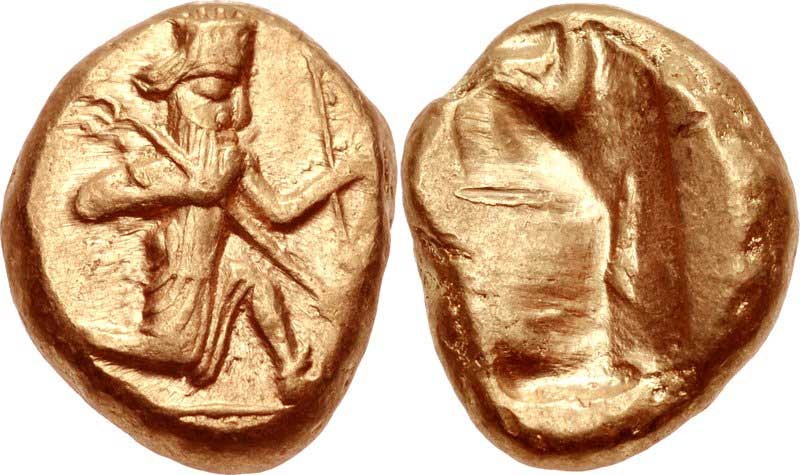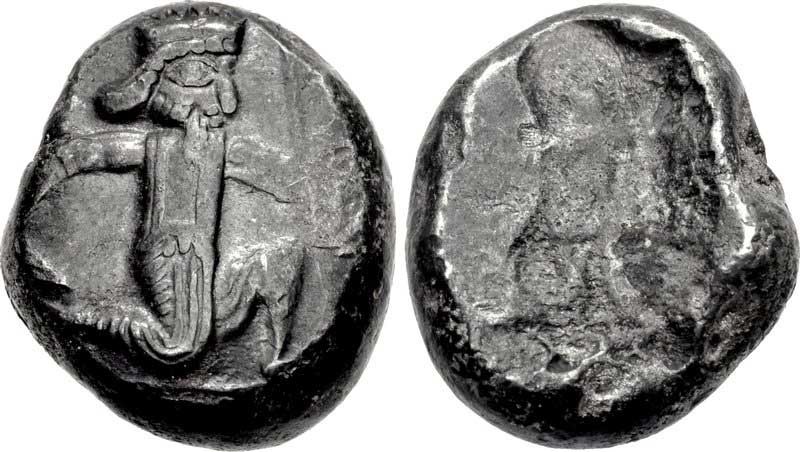NGC Ancients: Coinage of the Persian (Achaemenid) Empire
Posted on 8/13/2013
Though sometimes overshadowed by powerful Greek city-states and the Roman Empire of antiquity, the Achaemenid Persians founded one of the most powerful empires in the history of Western civilization. Early historical details are murky, but it would appear that the foundation of this important ancient empire was under way by about 650 BC. The first Persian king to be mentioned in contemporary historical sources is Cyrus I “The Great” (c.559/8-530 BC), who unified territories stretching from Central Asia to Phoenicia and Lydia.
In 547 BC, Cyrus conquered the Lydian Kingdom, then under the rule of King Croesus (c.561-547/6 BC). Croesus is a noteworthy figure in ancient numismatics, as he is believed to have pioneered the idea of a bi-metallic coinage system that contained both gold and silver coins of high purity. These coins featured on the obverse the confronted foreparts of a lion and a bull, and a simple incuse punch on the reverse. This example of a gold stater, thought to have been issued c.550 BC at the Sardes mint, is in exceptionally fine condition and is struck to the “heavy” weight standard of c.10.5 grams.
Initially, it seems Cyrus continued to issue these gold and silver coins of Croesus’ type after bringing Lydia under the Persian banner. This coin is an excellent example of a silver siglos that most likely was issued after the defeat of Croesus – it is thought to have been struck c.545-520 BC.
The next important Persian king, Darius I (c.522/1-486 BC), spent much of his career expanding upon the conquests of Cyrus. He was able to add lands ranging from Greece to Pakistan, and even invaded North Africa. From a numismatic standpoint, this king is important as the first Persian ruler to issue a uniquely Persian coinage. Breaking with the precedent of re-issuing the Lydian types of Croesus, Darius introduced a coinage with new designs in about 520 BC.
These silver coins (basic unit, siglos), were struck on small, thick planchets and feature a bearded archer (thought to represent the king or a hero) on the obverse, and an incuse punch on the reverse. This piece is an example of the earliest style of this series (c.520-510/05 BC) – the rigid archer is depicted from the waist up, with a bow and some arrows in hand.
The style of Persian sigloi, and their gold counterparts (basic unit, daric, which shared the designs of the silver pieces) underwent another evolution around 510-505 BC. Now, the hero-king is depicted as a full figure in a kneeling-running posture, with a quiver on his back, about to release an arrow. This gold daric, minted c.505-480 BC, illustrates the change in style.
Yet another stylistic change occurred c.490-480 BC, probably under Xerxes (486-465 BC), the son and successor of Darius. Though the obverse figure still occupies almost the same position as before, it now appears even more as if he might be in motion while still kneeling. Additionally, instead of drawing his bowstring, the figure merely holds the bow and with his right hand holds a spear.
Xerxes’ design for darics and sigloi would prove to be the longest-running of the Persian series. For about 150 years, the only significant change was to replace the king’s spear with a dagger, which happened on some of the issues starting in about 450 BC. The quality of die execution would decline over the ensuing decades. This siglos, struck c.455-420 BC and showing the figure with a dagger and bow, illustrates a stylistic degradation of the die work.
Interestingly, a stylistic recovery of Persian coinage took place c.375 BC. This daric, struck around that time, illustrates great improvement in the depiction of the hero-king.
This basic design would outlast the Persian Empire itself, which was conquered by Alexander III “The Great” during a five year period ending in 329 BC. The Greeks who oversaw the territories of the once-mighty Persian Empire elected to continue the coinage types of the Persians until c.300 BC. This daric was struck by an unknown satrap (regional ruler) of Alexander III, c.328-311 BC.
Images courtesy of Classical Numismatic Group.
Stay Informed
Want news like this delivered to your inbox once a month? Subscribe to the free NGC eNewsletter today!








